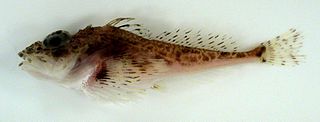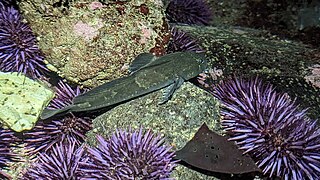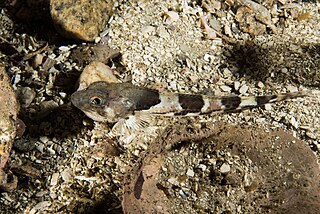
The scaled sculpins, Icelus, are a genus of marine ray-finned fishes belonging to the family Cottidae, the typical sculpins. Most of the fishes in this genus are found in the northern Pacific Ocean but they also occur in the North Atlantic Ocean.

The snubnose sculpin is a species of marine ray-finned fish belonging to the family Cottidae, the typical sculpins. This fish is found in the eastern Pacific Ocean.

The Pacific staghorn sculpin is a species of marine ray-finned fish belonging to the family Cottidae, the typical sculpins. This species is found in the eastern Pacific Ocean. It is the only species in the monospecific genus Lepidocottus.

Bellator militaris, the horned sea robin, is a species of marine ray-finned fish belonging to the family Triglidae, the sea robins. This fish is found in the western Atlantic Ocean.

Clinocottus acuticeps, the sharpnose sculpin, is a species of marine ray-finned fish belonging to the family Cottidae, the typical sculpins. This sculpin is found in the eastern Pacific Ocean.

The rosylip sculpin is a species of marine ray-finned fish belonging to the family Cottidae, the typical sculpins. This species is found in the eastern Pacific Ocean from Alaska to central California where it is an inhabitant of tidepools and other intertidal environments. This species grows to a length of 15 centimetres (5.9 in) TL. This species is the only known member of its monospecific genus Ascelichthys.

The roughback sculpin is a species of marine ray-finned fish belonging to the family Cottidae, the typical sculpins. This species is found in the eastern Pacific Ocean. The roughback sculpin is the only known member of the genus Chitonotus.

Blepsias cirrhosus, the silverspotted sculpin, is a species of sculpin belonging to the subfamily Hemitripterinae of the family Agonidae. This species is found the northern Pacific Ocean from the Sea of Japan and Alaska to San Miguel Island off southern California.

Blepsias bilobus, the crested sculpin, is a species of sculpin belonging to the subfamily Hemitripterinae of the family Agonidae. This species is found in the North Pacific Ocean.

Enophrys bison, the buffalo sculpin, is a species of marine ray-finned fish, belonging to the family Cottidae, the typical sculpins. It is found in the eastern Pacific Ocean.

Myoxocephalus scorpioides, the Arctic sculpin or northern sculpin, is a species of marine ray-finned fish belonging to the family Cottidae, the typical sculpins. This fish is found in the Arctic Ocean.

Artedius corallinus, the coralline sculpin, is a species of marine ray-finned fish belonging to the family Cottidae, the typical sculpins. It is found in the eastern North Pacific along the coasts of the western United States and Baja California.

Drepane longimana, commonly known as the concertina fishbarred sicklefish or banded sicklefish, is a fish native to the Indo-Pacific and northern Australia.

Sebastes rastrelliger, the grass rockfish, is a species of marine ray-finned fish belonging to the subfamily Sebastinae, the rockfishes, part of the family Scorpaenidae. It is native to the waters of the eastern Pacific Ocean.

The rosy sculpin is a species of marine ray-finned fish belonging to the family Cottidae, the typical sculpins. It inhabits the coastal northeastern Pacific Ocean, ranging from California (US) to Baja California.

The fluffy sculpin or Lizard Fish is a fish species in the sculpin family Cottidae. It inhabits the coastal northwestern Pacific Ocean, ranging from Kodiak, Alaska to Baja California (Mexico). Individuals reach up to 9 cm (3.5 in) in length, and are commonly found in tidepools, often associated with algae.

Triglops murrayi, the moustache sculpin, is a species of marine ray-finned fish belonging to the family Cottidae, the typical sculpins. This fish is found in the North Atlantic Ocean.

Icelus spatula, or the spatulate sculpin, is a marine fish in the family Cottidae. It can be found throughout the Arctic and the Northwestern Atlantic.

Icelinus borealis, or the northern sculpin or comb sculpin, is a species of fish in the family Cottidae. It can be found in the northeastern Pacific Ocean along the western coast of North America.

The Arctic staghorn sculpin is a species of marine ray-finned fish belonging to the family Cottidae, the typical sculpins. This sculpin is found in the Arctic Ocean and the northern Atlantic Ocean.




















